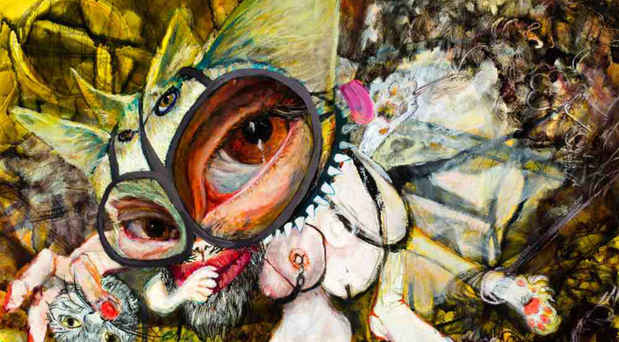“11th Biennial Exhibition - Making and Taking: Pictures Reconsidered”
A.I.R. Gallery

This event has ended.
This biennial results from an open invitation to female artists “investigating the intersection of hand produced and photographic pictures.” The call for submissions began, “A mutual interest linking painting and photography is as old as cameras. Lately, under the digital regime, it has taken a number of new turns. It may be that women have a particular stake in this relationship between the handmade and the mechanically or electronically produced, as between the provinces of subjective and commercial expression. “
To dig around a little in the show’s premise, and title: I was thinking, in part, of the old chestnut, “You don’t take a photograph, you make it.” It is a pronouncement made by Ansel Adams, he of the transcendent Western landscapes, seemingly given to him direct by the gods of sunlight, shadow and wind. But like landscape itself, Adams’s images, he tells us, weren’t there until seen and framed—and then shot, printed, and, we now know, manipulated. We know, too, that manipulated photographs go back to the birth of photography; soft-edged, hazily lit and symbolically rich Pictorialist images of the late nineteenth century were not the first to demonstrate that painterly effects could be achieved with a camera, light-sensitive emulsion, and various darkroom maneuvers. It is a tradition rich with women photographers, from Julia Margaret Cameron and Gertrude Käsebier to Sally Mann.
With the “Pictures” generation (to return to this show’s title), focal length changed, stepping back to include the viewer and, beyond, the commercial media that shape the way all images are seen. Photographs are not simply made, by a person with a camera and an idea; they’re constructed by the culture in which both artist and audience participate. As it happens, women artists—among them Barbara Kruger, Louise Lawler, Cindy Sherman, and Carrie Mae Weems, to name just a few—were leaders in the articulation of this insight. They and their younger peers have helped us see how the fluid boundaries between art and advertising, viewer and consumer, have been further blurred by digital technology. Its agile little devices can insinuate themselves anywhere, producing files that are a cross between information and image, mutable and mobile. Paintings can be made on an iPad. Photographs can be printed on canvas.
These, anyway, were the ideas, admittedly broad, behind the call for submissions. The number of respondents—over 800—was the first surprise. Others arrived in the cataracts of smart, funny, spiky and sensuous images that they sent in. I found, in them, a widely shared pleasure in mixing the digital and the analog and in violating technical protocols; in reversals, inversions, and shadows, and the representation of things that are not quite there. Photography, for these artists, is often a tool of introspection and of memory; painting a way of gorging on photography, of chewing it up and spitting it back out. There is photography without cameras, and nearly without images; it warps space and shifts the visible spectrum. But sometimes, in this work, the photographic (to borrow another chestnut) is just a glimpse, just as sometimes the pressures of painting are slight. Always, the hand at work belongs to an artist with a woman’s experience of the visible world, a fact that matters in the outcome.
A dozen more exhibitions could have been produced by this call; this one is not meant to be conclusive. But is a rich sampling of a vital field, and, maybe, an invitation to further taking, and making.
– Nancy Princenthal
Media
Schedule
from December 04, 2014 to January 03, 2015
Opening Reception on 2014-12-04 from 18:00 to 21:00
Artist(s)
Temme Barkin-Leeds, Kristi Beisecker, Susan Carnahan, Sophia Chai, Melissa Cowper-Smith, Erin Kyle Danna, Torrie Fox, Margery Freeman Appelbaum, Rose Frisenda, Kristin Furbeck, Karine Giboulo, Shohreh GolAzad, Susan Hambleton, Jasmine Higbee, Monica Hopenwasser, Donna Anderson Kam, Kharis Kennedy, Jessica Maffia, Erika Mahr, Kate McCammon, Ali Miller, Yasaman Moussavi, Josefa Mulaire, Ilona Pachler, Caroline Parks, Rebecca Shavulsky, Amy Swartele, Sarah West, Amanda Wild, Jeanne Wilkinson, Suly Wolff, Greta Young, Mary Zompetti